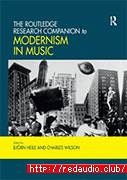- 资源介绍
- 下载记录
- 用户评价

音乐中的现代主义仍然激起人们的热情,并因争议而分裂。它扎根于 20 世纪初期,在二战后的近三年内实现了意识形态的主导地位,之后在本世纪的最后二十年成为广泛批评的对象,包括后现代派的评论家和作曲家。以及与“新音乐学”相关的著名学者。然而,这些批评未能削弱其持续的韧性。现代主义的图景已经相当广泛和多样化,并且一直是 21 世纪争论的关键焦点。本研究伴侣并不试图限制音乐现代主义的可能。同时,它反对对该术语的任何淡化,以免将其不加区别地应用于特定时期的几乎任何和所有音乐。
记录日期:2021-08-20 编号: LE416
26MB
![]()
| 出版: | 类别: | 电子书 | |
| 格式: | PDF,EPUB | 页数: | 536 |
| 日期: | 2021年8月20日 | 编号: | ISBN: 036773303X |
| 语言: | 英文 | 提供: | |
| 主页: | 备注: | 链接失效请反馈或联系客服;付费后请及时保存! |

2022-06-18 浏览:65
Introduction to Post-Tonal Theory, 4th Edition
2021-09-04 浏览:61
Beat Workzone English Edition 02.2021
2021-08-29 浏览:51
Thought and Play in Musical Rhythm
2021-08-31 浏览:48
The Oxford Handbook of Music and Advertising
2021-08-24 浏览:45
English and German Diction for Singers: A Comparative Approach
2021-08-24 浏览:42
The Dark Side of the Moon: The Making of the Pink Floyd Masterpiece
2021-08-31 浏览:42
共有 条评论